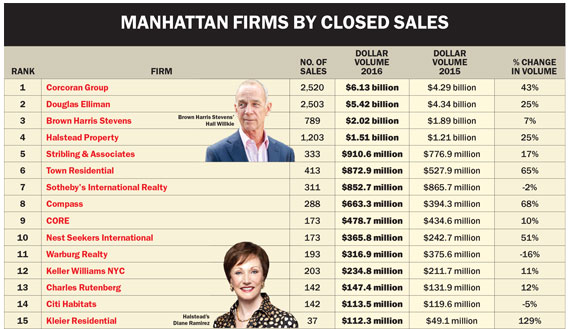Trending
Which residential firms sealed the most deals?
A ranking of the Holy Grail of transactions — closed deals

Back in 2014, when buyers were frantically scooping up not-yet-built condos off of floor plans, the city’s leading residential firms must have been dreaming of the moment when those deals would close. That moment has finally arrived.
Thanks to a wave of condo sales that are hitting the books, Manhattan’s top brokerages are going to the bank with deals that were in the works for many months — or even years — according to The Real Deal’s second-annual ranking of closed sales listings.
The ranking, like the others in the magazine this month, is based on data pulled from listings portal On-Line Residential. It includes closed transactions in Manhattan for which the firm held the exclusive listing during the 12 months that ended on February 29. It does not include buy-side deals.
As a group, the Top 25 firms on this year’s list closed more than $20.8 billion worth of listings during the 12-month stretch, according to TRD’s analysis. That’s a 26.6 percent jump from the $16.5 billion sold by firms on last year’s list.
This year’s closed sales volume mirrors the meteoric price increases in Manhattan residential real estate over the past few years. In fact, most of the Top 25 firms saw a smaller number of closed deals than in 2015 — even though the vast majority of them sold a higher dollar volume of exclusives.
This year, the Corcoran Group edged ahead of rival Douglas Elliman to nab the No. 1 spot, with $6.13 billion worth of closed listings — up a stunning 43 percent from a year earlier. The firm also said it helped to sell an additional $1 billion that were not included in TRD’s ranking. “Corcoran served as an advisor to Extell Development on One57 and the Carlton House, two of Manhattan’s highest-grossing projects,” said company President and CEO Pamela Liebman.
Meanwhile, Elliman closed $5.42 billion worth of listings, up 25 percent from 2015. Interestingly, Corcoran had a lower dollar volume of listings than Elliman. But executives at Corcoran are likely sleeping easy, given that closed sales matter most.
Rounding out the top five were Brown Harris Stevens with more than $2 billion in closed sales, Halstead Property with $1.5 billion and Stribling & Associates with $910.6 million. All five firms sold off more listings this year than they did in 2015.
“Right now, you see a ton of new developments closing. We finally hit that part in the cycle,” said Stribling President Elizabeth Ann Stribling-Kivlan, who noted that her firm’s current pipeline of new condo projects is also strong.
“We’ve worked hard for our developers and it’s paying off,” she added.
Big gainers, losers
The biggest gains on this year’s list not only came from heavy hitters at the very top of the ranking. At No. 6, Town Residential sold $872.9 million worth of listings, up 65 percent from 2015. Compass, which clocked in at No. 8, saw a 68 percent jump in sold listings to $663.3 million. And Nest Seekers International sold off $365.8 million worth of listings, up 51 percent.
Smaller firms on the list posted the biggest jumps, percent wise, such as Kleier Residential, Engel & Völkers and New York Residence.
Halstead’s CEO, Diane Ramirez, whose firm saw closed sales listings jump 25 percent from 2015, echoed others, saying new development is “a very important segment of the market.”
But she cautioned that it can be a double-edged sword. “If it’s in a price point where [the market] inventory is low, it’s an exciting driver” of business, she said. “If it’s challenged with a lot of [competing] inventory, it won’t be.”
 To that point, several brokerage heads expressed concern that the market for ultra-luxury condos is getting oversaturated. They pointed to price cuts at the top of the market as a sign that demand has shifted.
To that point, several brokerage heads expressed concern that the market for ultra-luxury condos is getting oversaturated. They pointed to price cuts at the top of the market as a sign that demand has shifted.
And an impressive roster of listings doesn’t always translate into an equal number of sales. Power broker Dolly Lenz’s firm, for example, sold $46 million worth of listings, down from about $79 million, according to TRD’s analysis. Lenz, who by comparison had $419.5 million worth of listings, did not respond to requests for comment.
Similarly, townhouse specialist Leslie J. Garfield sold $92.2 million worth of listings, a jump from last year’s $71.69 million but still a fraction of the firm’s $166.3 million in listings. And the Modlin Group, which racked up $278.8 million in listings, sold off just $76.9 million worth of exclusives, down from about $130 million last year — although that number does not include the firm’s strong buy-side business, Modlin said.
Other firms saw smaller dips in closed sales, including Sotheby’s and Warburg Realty. According to Warburg President Clelia Peters, mint-condition resale units “are not selling overnight, but they’re not sitting as long as many new developments.”
The reality is that the market is driven by the needs of “everyday” New Yorkers, she said. “[They] are buying more in the $2-million-to-$5-million range than they are in the $10-million-to-$20-million range.”
The new ‘normal’
The relatively stable resale market is helping deals get done, brokerage heads said.
CORE’s Shaun Osher, for example, said buyers and sellers are standing on equal footing these days, which is leading to more transactions.
Coming in at No. 9, CORE sold $478.7 million worth of listings for the 12 months ending on February 29 compared to $434.6 million last year. While Osher said he is “probably the only person who doesn’t think the ultra-luxury market has slowed,” he conceded that CORE’s resale business — particularly deals between $2 million and $5 million — represented the bulk of his sales over the past year. “Good properties are still selling very well,” he said.
CORE’s nearly $479 million worth of sold listings eclipsed its $293.6 million worth of exclusives.
Olshan Realty’s Donna Olshan said the under-$2-million segment is the strong price point as well. “That’s where the velocity is and where the majority of deals are for all the firms,” she said. “Everyone likes high-end, but you’ve got to do it all.”
In the current “normal” market, skilled brokers have to bring buyers and sellers together, said Modlin. “All of a sudden when there’s uncertainty in the world and global markets slow … there’s a more limited pool of buyers, increased supply and a market adjustment.”
The pricing puzzle
No matter the price point, the brokerage community’s rallying cry this year is pricing.
With the global economy and interest rates rising (albeit only slightly), buyers are simply not willing to overpay.
“It’s fair to say no one has tested how many penthouses you can really sell for $80 million to $100 million,” said Thomas Guss, president of New York Residence, which unloaded $64.2 million worth of listings. “The developer these days who thinks properties will sell out in 18 months is too optimistic. People have a lot of choice.”
Brown Harris Stevens CEO Hall Willkie hit the same note. “Having a listing is one thing, but if you overprice it you don’t have a sale,” he said.
BHS — whose listing volume remained relatively flat this year at $2.24 billion — closed more than $2 billion worth of deals, up from $1.89 billion last year.
Willkie and others said there’s no doubt the market is correcting itself after the breakneck speed of 2013, 2014 and early 2015. He also joked that buyers respond to news of a changing market immediately, while sellers take a while to realize their apartment may be worth $850,000 instead of $1 million. “We laugh and say you want to be broker No. 3 for when the seller gets reasonable,” he said.




